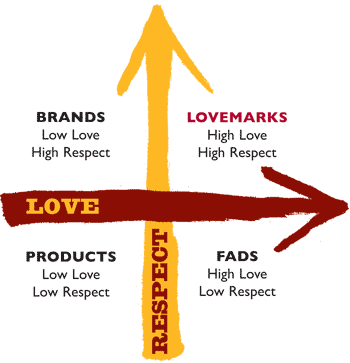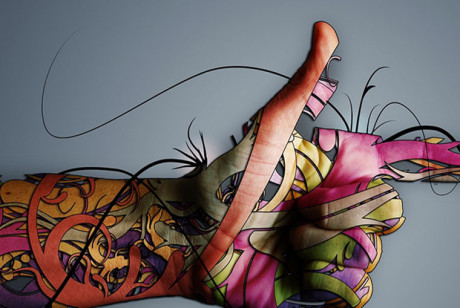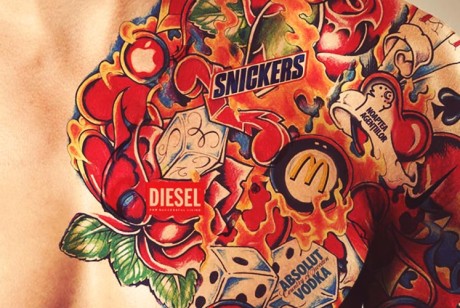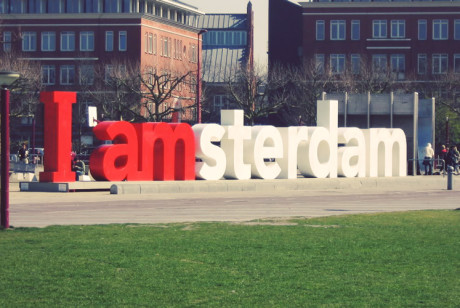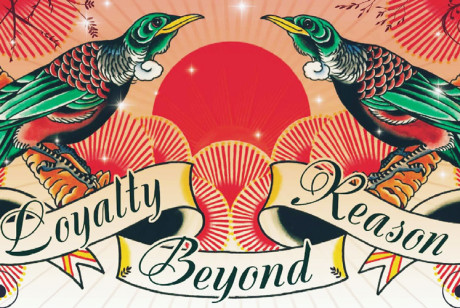What’s Love Got to do With It?
Wednesday, 26 May 1999 - Hamburg, Germany
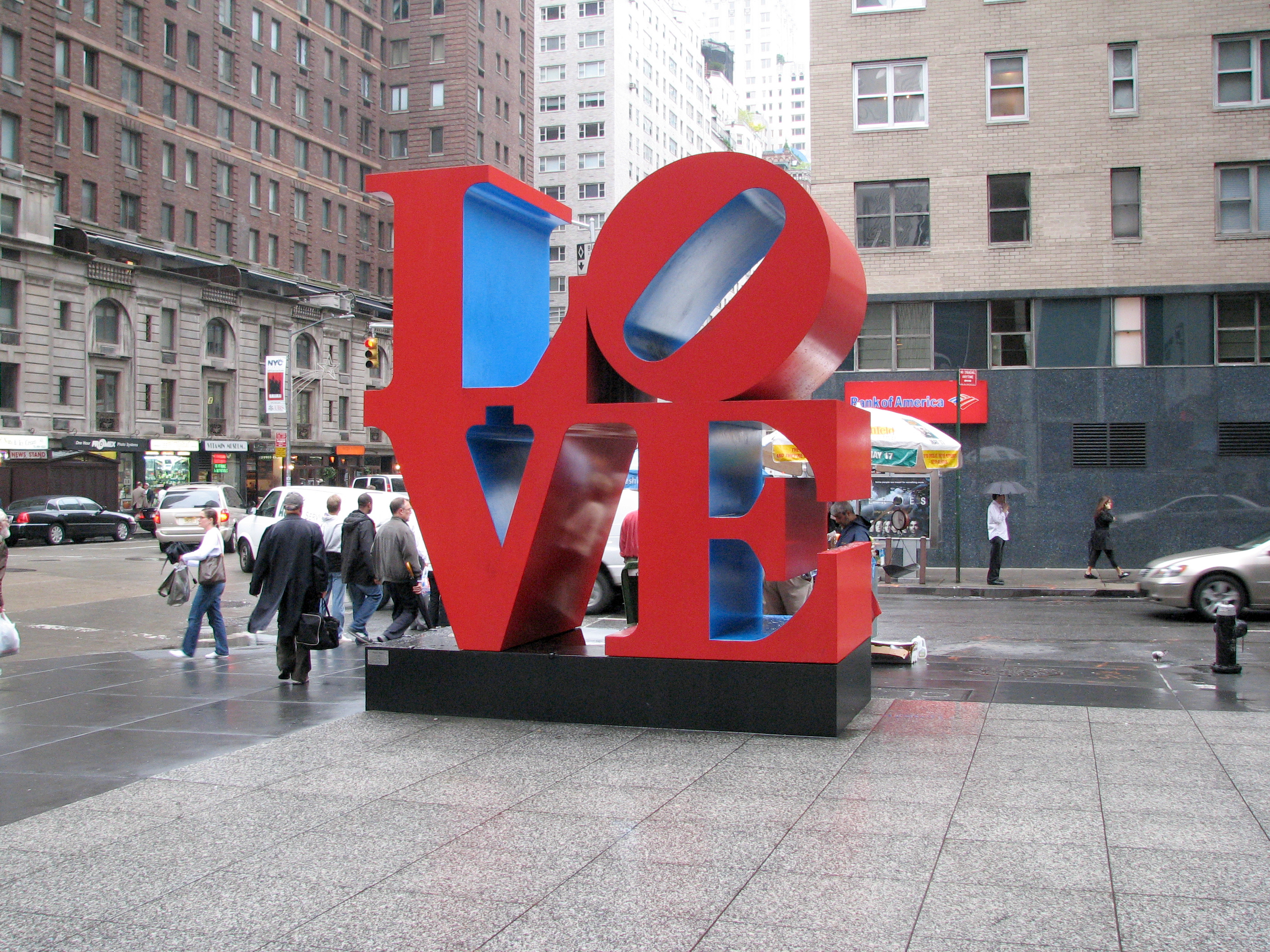
Presentation Summary
A keynote address to the World Magazine Congress. Naysayers who prophesize the demise of the print media miss the point. In the Attention Economy, when all communication must strive to make an emotional connection with consumers, the narrowcast and intimate nature of the magazine will become more valuable than ever.
As part of my absolute affirmation of your medium, I’m going to present a brand new magazine to you. Right now.
It’s one of the finest publications I know of. Tightly targeted. Highly relevant to its audience. Full of the eclectic, serendipitous delight that is so unique to magazines.
This magazine has been going about two years and I’ve got extremely high expectations that it will continue to prosper. It’s insightful, radical and it feeds me amazing stuff.
Circulation is stable. At the moment it stands at an audience of one. Me. Best of all, it has a picture of me on the cover of every issue.
This is Swerve. A digest that one of my renegade thinkers down on the edge in New Zealand prepares for me from 50 or so great magazines that I don’t have time to read.
This guy thinks he knows me better than I know myself. This makes him a great editor. He feeds me articles about the things he knows I’m passionate about. And he’s always looking for material in new areas that will extend and excite me.
Swerve is my lifeline to the magazine world I love so much. (I’m open to licensing offers after my presentation. The only condition is that I continue to appear on the cover of each issue).
I love magazines for the storytelling, the ideas, the images, the discoveries they give me, the gossip, the mine of information that, when you thread connections between it, can make you millions.
As the head of a global communications organisation that advocates spending hundreds of millions of dollars a year on magazine advertising space, I’m committed to the creative potential of magazines and print ads to connect with consumers.
This morning I want to focus on four things: these emotional connections with consumers that I have already mentioned; what is called the “attention dilemma”; the role of context, or point-of-view, in ushering in the next great age of magazines; and something deeply unfashionable, “paper”.
Everyone it seems has a view about the future of print. Some of the most gutsy – and sceptical – views come from cyber-optimists like Nicholas Negroponte.
His line is “if you want to talk about the future of newspapers, the first thing you have to do is to separate the news from the paper.” It’s a great line. However, the cyborgs relegate paper to artefact status. Lead squirted onto dead pulverised trees and trucked from factory to fencepost. You’re in the manufacturing business guys!
I disagree. We are using more paper now than ever before. UK paper use, for example, is up 65% on ten years ago. One of Saatchi & Saatchi’s global clients, Hewlett Packard, estimates that the US produced 860 billion pages from copiers, fax machines and computer printers in 1996. That’s three years ago. Imagine applying Moore’s Law to this equation.
People are printing out from their computers more than ever. Even Bill Gates says he’ll only read anything over four screens on paper.
No one wants to read stuff off a computer screen. It’s too hard on your eyes. It isn’t portable. You can’t hold it in your hands. You can’t scribble notes in the margin. And a laptop doesn’t read so well after you’ve dropped it in the bath.
Computer screens aren’t up to it yet. In fact the whole computer interface is incredibly flunky. The PC is still a clumsy device that sits on your desk and doesn’t even know who you are. Donald Norman from Hewlett-Packard said recently that “the personal computer is fundamentally too complicated.” He’s right.
We are still waiting for the computer interface that delivers a truly engaging interactive experience. Computer screens don’t inspire. They don’t reach out and effect a viewer’s emotions. They just don’t connect emotionally. And marketing is all about making emotional connections with consumers.
Until the Internet can really move a consumer the way the movies can, or it becomes a deeply loved part of people’s everyday routine like a favourite magazine or the morning newspaper, it’s not going to be the great threat that the critics of print would have you believe.
The most telling insight about the relationship of the Internet to print media comes from looking at the media consumption of Internet users. The heaviest users are the most avid newspaper readers. What the Internet is really hurting is television, in the home, in the evening.
I’m not taking the over-hyped online media threat to magazines seriously. Maybe when someone comes up with a valid on-line business model I might reconsider.
If I was in the paper business I’d be more concerned about the threat of electronic paper than the Internet. Electronic paper and e-ink are exciting prospects, but they are only going to be valid alternatives for magazine publishing when they can outperform all of paper’s great qualities and can be read after being immersed in bath water or coffee stains. That’s still a long way down the track.
In the meantime, print will continue to thrive.
As the information architect Richard Wurman says, we live in the Age of Also. No new medium replaces an old one. It just adds to the consumers list of choices.
More media just breeds more media. Newspapers, magazines, radio, the movies, network TV, cable, satellite, video, the Internet, inflight, skywriting . . .
Not only do I have my own personal magazine, I also have my own personal website – saatchikevin dot com. This speech will be published there this afternoon.
There’s a place for it all, because people want it all. Media consumption keeps increasing. People want more candy for their eyeballs, and we’ve got bags of candy to give them. So they get more channels of TV, more websites, more magazines, and through it all, more advertising.
We are a media-obsessed world. In the developed world, media has become an element of our sustenance as vital as food. In fact we now have a market demographic that spends more per week on media than on food.
We are becoming defined more and more by the media choices we make. One of the most revealing questions we ask in recruitment interviews is “what magazines do you read?” Closely followed by “how do you socialise?” and “who’s your favourite athlete?”
And what’s behind this great media explosion?
In the magazine business, as Rupert Murdoch said last year, it’s the digital revolution in production and distribution. Faster. Cheaper. Easier.
Digital technology has sent the media everywhere. It’s become our new religion. Many of you here today are its missionaries. Your mission is all about spreading the gospel and winning new eyeballs.
The future of magazines is digital. Digital production and distribution is cheap. Or if it isn’t yet, no one denies that it will be soon. Visionary organisations like Presspoint are taking the first steps down the path to online distribution and on-demand printing.
It’s an on-or-off digital choice. Extinction – or digital design, digital printing and digital distribution.
These days “being digital” is the table stakes that gets you onto a level playing field.
In agencies and magazines we’ve been using digital design tools to expand our creative boundaries for years. Digital design technology has become a creative tool as indispensable to us both as the pencil. The flexibility, cost and speed advantages of being digital will keep on adding new indispensable technologies to the rest of the production and distribution business model.
But we have to keep the table stakes in perspective. Technology will always only be a tool in the much bigger process of making connections with the human heart. That’s a creative process that has very little to do with binary codes and a lot to do with people.
One opinion I respect comes from the guy who sells me the best bagels in New York. He says “Digital Schmigital”. It’s just too easy to get too carried away by all the hype about technology, says my bagel man.
Technology is part of the answer. But it’s only a small part. In many cases it’s actually the problem.
The technology that is bringing us the greatest ever explosion media options is also bringing us the greatest ever crisis of the media. It’s a crisis of too many attention options.
You all know the argument. People today are time-poor and stressed-out. They have increasing demands on their attention. People can’t absorb or react to all the competing messages they are confronted with each day. There is just so much stuff out there, hundreds of television channels, thousands of magazines and millions of websites, billions of faxes, emails and phone calls. It’s too much information and too little understanding.
It’s a disaster for everyone. Your magazines and my ads are at constant risk of being drowned out by background noise. Consumers have never been more at risk of being left helpless by the bewilderment of information and choices they face every day.
Welcome to the Attention Economy. The scarcest and most valuable commodity in today’s economy is consumer attention.
No matter what kind of business or organisation you are, your first job in this crowded narrowcast world is competing for the attention of consumers. That’s the eyeball part. Then the real job begins – making connections with the hearts, minds, guts and nerve ends of consumers.
The ability to create those connections, not the number of eyeballs you can access, is going to decide the media winners.
The effectiveness of any communication is determined by the depth of the emotional connection it creates with its audience. The best connections are based on love.
I’ve been in brand marketing for over thirty years. I measure the connections between consumers and brands on this Love/Respect Axis.
Connections based on love beat connections based on respect every time. In markets with competition as intense as yours, the winners are going to be the lovers.
High love connects. The ideal relationship to have with your customers, your readers and your partner, is a connection based on high love and high respect.
From here on in, if your magazine isn’t loved by your readers then it is not going to succeed.
Magazines are a fantastic product to compete for love with. The combination of the tactile experience, quality of reproduction, portability, the reassurance of print and the tight targeting of audiences, makes magazine reading an intensely personal experience that is all about connecting with consumers.
Magazines will continue to cut through the confusion of information overload and prosper in the Attention Economy. But it won’t be digital printing that makes consumers love you.
And contrary to the common view among those who occupy themselves building massive vertically integrated media empires, it won’t be content.
Content is actually the problem. It’s just more information. It’s feeding our information anxiety. We don’t need any more content, we need context.
Context is what makes sense of information. It is the vital link between information and understanding. Context is what really tells the story.
Context is all about ideas. Ideas that link different pieces of information together through point-of-view. Ideas that define how we judge our world and how we see ourselves.
Forget about the Information Age. It’s over. This is the Age of the Idea.
Ideas that cut through information anxiety and connect with consumers are the supreme premium products of our age. Consumers are crying out for ideas that give them a context to view the world with.
That’s why I’m so confident about the future of magazines. Because the best magazines are storehouses of ideas. They are a reassuring voice of context that cuts through the conflicting messages of the Attention Economy.
The demand for context explains the popularity of digests, like Cover magazine from Britain, or the Utne Reader from the US. Utne Reader is a great example. Pure humanist alternative context in a media market swamped by opposing points of view.
Context explains the “Lad Mag” phenomenon. Until Loaded magazine came along conventional wisdom said if it wasn’t just about women, cars or sport then no men would be interested. Conventional wisdom said that no man would want to read about fashion. I’m sure that quantitative research supported that view. But the success of Loaded and all the titles it inspired showed that men did want to read about fashion. What they needed first was a new context to make it relevant to them.
Great magazines make consumers feel connected to a community. They offer a point of view that is distinctive from the rest of the market and that the reader trusts. They present readers with information that excites and inspires them because it’s so relevant. The great magazines give the reader confidence and offer a route through the confusion. And they offer serendipity. The surprise, intrigue and delight of discovery. Great magazines are the ultimate interactive, tactile medium – they offer real emotional involvement.
A great magazine is a mirror of the special breed of people that create it. People who are intensely curious about the world, and passionate about sharing their world view. I know this because they are the same people who succeed in advertising agencies. They are driven by inspiration, imagination and intuition. This is the territory where the telling insights about brands and consumers, readers and magazines, and the connections between them, are located.
As competition from other media intensifies, these insights are going to be the key to your success more than ever before. The irony is that when all the talk is about technology, the X-factor that will decide your success is going to be your editors. Those people who create point-of-view that speaks directly to consumers. This is an act of high creativity. It’s the product of fine human insight, judgement and intuition. You can’t write computer code for that.
In all, this signals that we are entering a new golden age of the editor. Great magazines are defined by visionary, gutsy, stubborn editors who trust their instincts and refuse to listen to the pessimists.
Creativity is a rare thing. Brilliant editors don’t grow on trees like MBAs. There are only about 20 people in the world at this moment capable of driving competitively in Formula One motor racing. This is probably the same number of people who can consistently turn out a breathtaking, world-changing magazines that retain relevance to consumers every edition.
Look at Wallpaper, one of my favourites. This magazine is a seriously big idea. It’s revolutionary. It’s connecting to global consumers by creating a new idea of world style. It’s a mix of mid century jetset glamour and modernist architecture, Scandinavian design and a fantasy of chic millennial urban consumerism. And it’s doing it with an assiduous avoidance of celebrity.
Along the way, Wallpaper is creating an entirely new, truly global consumer segment.
Wallpaper, like Wired and like Fast Company and other recent startup magazines, defied common wisdom and would have bamboozled research subjects.
Wallpaper’s editor is Tyler Brule. His stubborn dream and visionary creativity is the reason for the success of the magazine.
The most fundamental challenge in all business is building brand equity.
Great editors like Tyler understand that the thing that’s going to determine the long-term success of your company is not whether you have an Internet site or not. It’s going to be what your brand stands for in minds of magazine consumers.
The critical challenge for companies in all industries remains unchanged – to create and nurture a brand that consumers love and trust and use year after year.
Too many CEOs and publishers have opted out of this task. They are focussing on circulation figures, quarterly earnings and re-engineering. They’ve forgotten job number one – loving their consumers and building brand equity through emotional connections.
Magazines are bad marketers of themselves. I can’t remember the last breakthrough billboard I saw for a magazine, or a magazine campaign that got an award at an advertising show.
Look at what your competition is doing. I can’t remember the last day I spent without seeing high impact advertising all over the place for some new movie or TV show.
And marketing for magazines doesn’t stop at consumers. The other element in your vital business equation is me – representing your advertisers. Marketing your brand has as much to do with your relationship with advertising agencies and the brands we represent, as it does with consumers.
Look at the facts. Magazines total share of global advertising spending is shrinking. Our clients have far more choices today about where they spend their advertising budget. It means you have to work harder for your advertising.
TV is still number one for ads. No other medium can compete with television’s ability to capture consumer attention with the emotional power of moving pictures and music.
In most markets, print advertising is a distant second. But it’s by no means yesterday’s medium.
As the media fragments and there’s more pressure on budgets, TV looks increasingly expensive and inefficient.
Most advertising people agree that the creative potential of TV is pretty much understood. Anything seemingly new is just going over old ground.
Connecting with increasingly ad-literate and cynical consumers from here on in is going to take even more creativity. Magazines have a whole new set of possibilities.
Magazines have a unique interactivity. They are the only medium capable of engaging all five senses.
At Saatchi & Saatchi we believe that print is a medium with exceptional unexploited creative potential.
The first thing we’ve got to do to unlock that potential is to get a dialog going between our creatives and your editors.
Why do you never see an editor with the creative director of an advertising agency? These people are soul brothers and sisters, but they never seem to meet.
Maybe there is some hangover prejudice against advertising as a necessary evil among editors. If that still exists, magazine editors have to get over it once and for all . . . and now.
Magazines and advertising agencies are playing the same game. Great advertising connects just like a great magazine article. It inspires, delights and surprises consumers.
Great magazine advertising helps build a magazine’s brand equity. Great ads communicate a set of values that make the consumer love them. The more love you can get into your magazine, the better for your brand.
Magazines must love their readers, but they must love their advertisers equally.
More editors should be out there courting the brands with values that best match up with their vision of the magazine brand. They should be offering them insights into their readers and ideas about how to make connections.
The most switched-on magazines we work with around the world are already doing this. In Australia, for example, where there is terrific competition between the Murdoch and the Packer empires, magazines are always coming to us with ideas we can use to connect with their readers.
They are sharing their newest insights into their readership. They are exploring with us new technologies and new technical possibilities for creating new kinds of ads in magazines. They are pestering us with ideas about how they can help us connect with their readers, and we love it.
The Attention Economy demands that brands work together to connect with consumers.
We want to be doing more of this. We want to be hooked into the creative minds that are driving your brands. Share with us your insights about your readers.
We don’t want to hear circulation figures, save them for your press releases and the media agency. Don’t bother with the broad demographics about your readership. I’m not interested in eyeballs, I want hearts, minds, guts and nerve ends.
I want qualitative not quantitative research. I don’t believe that numbers and averages have magical power. Quantitative at best is all about being approximately right. Usually it’s about being exactly wrong.
So give me insights, not analysis. Tell me about what that reader is feeling. Tell me their fears. What they love. We want to know how your magazines are connecting.
The stark truth for magazines is that advertisers are your most significant revenue source. You must, for your brands, bring agencies onto your team and use our clients’ brands to help you connect with your and their consumers.
So this is my five-point plan to usher in the great age of magazines.
- Make emotional connections with readers to cut through the Attention Economy.
- Create context for your readers, not content. Context equals brand plus ideas.
- This is the golden age of the editor. Treasure your creative people.
- Invest in building your brand equity.
- Love your advertisers and their agencies.
From here on in it’s going to be a more crowded, more fiercely competitive world than ever before. Success in this environment for all media will be all about how much you are loved by your audiences, and how effective you are as a matchmaker for your audiences and your advertisers’ brands.
I’m excited about how magazines will perform from now on. I love magazines as a reader and I’m convinced that magazines can be one of the hottest advertising mediums around.
If magazines can get it right you will not only survive, you will usher in a new great age of magazines.
Agencies and magazines have so much in common – we are both populated by crazy, creative ideas people who are passionate about connecting our brands with consumers. We both live or die by the ideas we offer consumers. We both exist for connections with consumers built on love and trust.
Let’s make magic together.
Kia Kaha.
